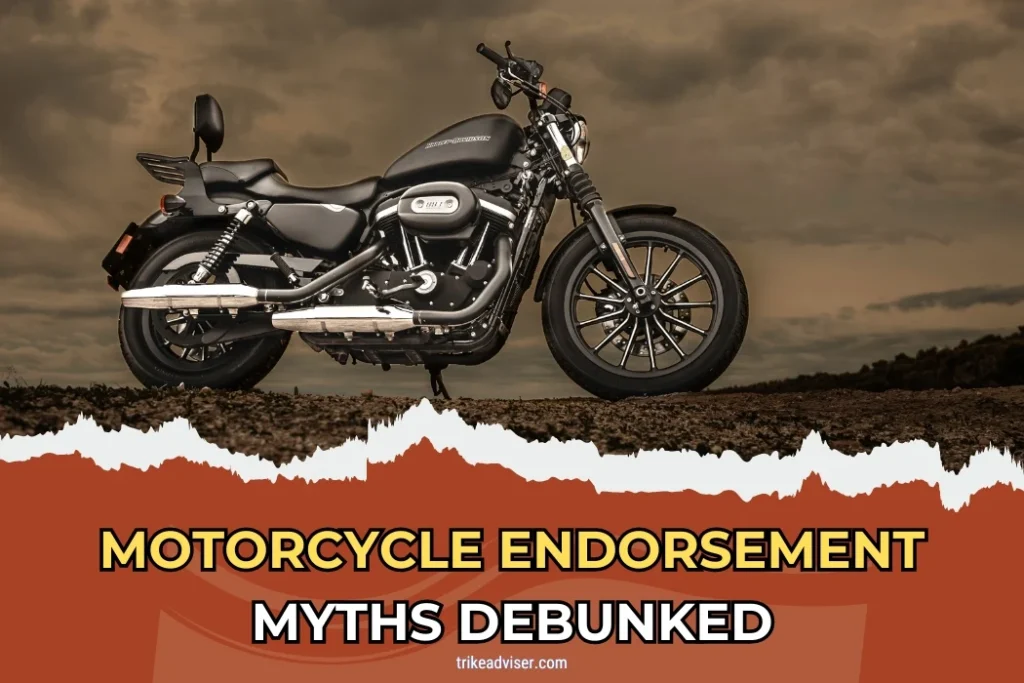Many riders hesitate at the thought of getting a motorcycle endorsement. They hear it’s a nightmare. It’s not. This process may seem packed with roadblocks, more mental than real.
Are you avoiding the DMV’s winding lines and complex paperwork? Do tales of tough tests and picky inspectors fill you with dread? Let’s clear the air.
A bit of prep and understanding can smooth out most bumps. It’s less about the challenge and more about the right approach.
Does the thought of added freedom on two wheels appeal to you? If so, shaking off these myths might be your first step toward open roads.
Motorcycle Endorsement Myths Debunked: Is It Really That Hard?
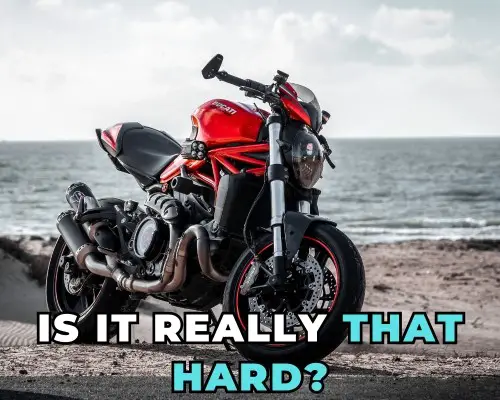
Navigating the path to a motorcycle license might seem like navigating a labyrinth. Fear not; with a dash of dedication and the right guidance, it’s a journey well within your reach.
Let’s dispel the fog around common myths, offering not just steps but also insights that feel like insider secrets.
The Written Test: More Approachable Than You Think
Picture your first big hurdle: the written test. While it’s perceived as more daunting than the car version, it’s a manageable beast.
The test will challenge your knowledge of motorcycle jargon, traffic laws, and safety protocols. Here’s a tip: the DMV guide isn’t just a suggestion—it’s your playbook. Dive into it with the same energy you’d bring to learning a new riding route.
Statistics show that with the right preparation, most applicants don’t just pass; they excel. Take practice tests online—they aren’t just quizzes, but a sneak peek into your actual test day.
The Basic RiderCourse: Transforming Novices into Riders
Take in the Motorcycle Safety Foundation’s Basic RiderCourse (BRC) to start your path to becoming a confident rider. This isn’t just a class—this is how the riding community is introduced to you for the first time.
Over 350,000 new riders enroll in the Motorcycle Safety Foundation’s BRC each year thanks to its extensive curriculum, which covers everything from throttle control to safe stops.
Course Highlights:
- 5 hours of theory: More than lectures, these are interactive sessions where you’ll learn the psychology of riding.
- 10 hours of practical riding: Under expert supervision, you’ll practice on a closed course, mastering the art of smooth turns and emergency responses.
Enrollment prerequisites are simple: know how to balance a bike and have the appropriate permits. Some sites even lend you gear, easing your entry into this new world.
Why the BRC Matters
Completing the BRC can lead to not only waiving the on-road test but also scoring you insurance discounts—often up to 15%.
More importantly, the BRC is statistically proven to reduce accident risks. It’s your foundational building block in safe riding.
The Road Test: Your Final Mile
Make a good impression by approaching the road test as though it were a first date with your bike. It’s important to demonstrate that you can operate your bike in practical situations rather of just flaunting your skills.
Practice in various weather conditions and familiarize yourself with different traffic patterns. Remember, the right gear is as crucial as your riding skills. Gear up not just to pass but to protect—motorcycle gear reduces the risk of fatal injury by 37%.
Preparing for the Motorcycle Endorsement
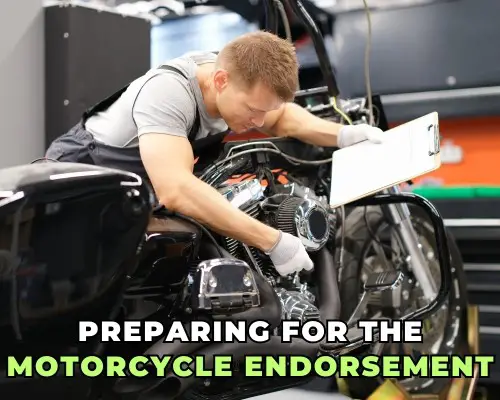
Obtaining your motorbike endorsement is similar to packing for a major trip in that both require planning and the proper equipment, in this instance the necessary papers and knowledge.
Eligibility Requirements
Navigating the eligibility maze can feel daunting, but it’s really about ticking the right boxes:
Age Considerations:
- Teens (16-17 years old): It might seem like a hurdle, but completing a state-approved motorcycle safety course is your golden ticket. This isn’t just a requirement—it’s your foundation in riding safely and skilfully.
- Adults (18+): Here’s a little-known fact—taking the Rider Course could skip the queue for you, allowing you to bypass both written and practical tests. Think of it as a fast pass to the open road.
Prerequisites:
- Essentials: You need a valid driver’s license or permit to step into the world of motorcycle courses. Consider this the first gate to pass through on your journey to endorsement.
- Mandatory Training for Teens: For those under 18, not only is completing a Rider Course required, but it’s also a crucial step in building the skills that ensure you’re road-ready and safe.
Legal Must-Dos:
- Safety First: When 16 and 17-year-olds have to finish a motorbike safety course, the legislation isn’t just being severe. The National Highway Traffic Safety Administration states that knowing how to handle your bike in challenging situations greatly lowers the danger of an accident. This training goes beyond simply teaching you the right moves to follow.
Documentation Needed
Think of gathering your documents as packing for a long-awaited road trip. Each piece is essential:
Completion Card:
- Unlocking Shortcuts: Completing the BRC or BRC2 not only arms you with vital riding skills but also rewards you with a Completion Card. This isn’t just a piece of paper—it’s your fast-track ticket past the DMV’s testing hurdles, applicable for those 18 and older.
Log of Experience:
- Building a Portfolio: If you’re between 16 and 17, this log is your diary of growth. Documenting 50 hours of riding might seem like a chore, but it’s logging your journey from novice to knowledgeable. Each hour is a step closer to mastery.
Waiver Form:
- A Minor Detail: For minors, this form is more than paperwork—it’s a pledge of safety from your guardians that’s taken seriously by course providers.
Additional Documentation:
- Beyond the Basics: Bring along your driver’s license, proof of identity, and any other documents your DMV specifies. It’s like checking the weather before you head out; knowing what’s required ensures no surprises on test day.
Practical Training – The Basic Rider Course
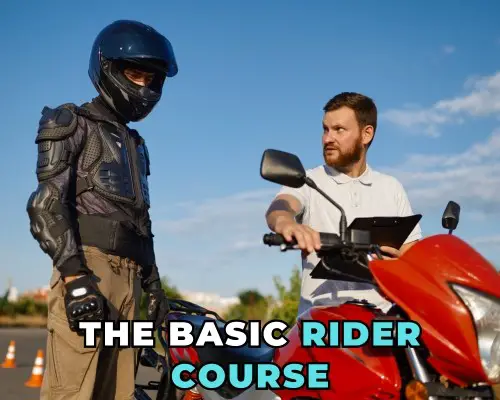
Starting the Basic RiderCourse (BRC) lays the groundwork for a lifetime of safe and enjoyable riding, not just a way to cross something off your licensure checklist.
Let’s see how this course helps novices become comfortable riders and how experienced riders can improve their abilities.
Choosing the Right Course
Selecting the right motorcycle course should feel as intuitive as picking the bike that fits just right under you.
- Consider Your Experience Level:
- Beginners: The BRC is your gateway. It introduces the thrill of riding within the safety of structured learning, perfect for those just starting.
- Experienced Riders: Feel like you’ve got the basics down? The BRC2-LW or Advanced RiderCourse will fine-tune your skills, pushing your riding abilities to new heights.
- Check the Course Structure:
- Personal learning styles matter. Whether it’s the camaraderie of group learning or the tailored focus of one-on-one sessions, ensure the course structure suits your way of absorbing information.
- Look for MSF Certification:
- MSF-certified courses are gold standards. They guarantee you’re learning cutting-edge techniques and receiving top-tier, updated safety education.
- Check the Equipment:
- The gear and bikes provided are not just tools; they’re part of your safety kit. High-quality, well-maintained equipment is essential and ensures you can focus on learning without worries.
What to Expect During Training
The BRC is meticulously designed to prepare you for both the roads and the unexpected.
- Classroom Instruction:
- Far from dry lectures, these sessions are interactive, designed to engage you with real-world scenarios and develop your rider’s intuition. You’ll learn not just to ride, but to anticipate and react.
- Riding Sessions:
- Practical application is the soul of the BRC. You’ll get hands-on experience with everything from basic controls to advanced defensive maneuvers. Each session builds on the last, transforming abstract concepts into instinctual actions.
- RiderCoach Feedback:
- Your RiderCoach is your mentor. They provide bespoke advice and corrections, adapting their coaching to suit your riding style and progression.
- Safety First:
- Feeling overwhelmed? It’s okay to speak up. The BRC emphasizes creating a supportive environment where safety is paramount. Your comfort and confidence are key indicators of a successful training session.
Continuing Education
- Post-Course Practice: Don’t let your skills stagnate. Regular riding post-course helps cement the techniques you’ve learned into muscle memory.
- Advanced Training: Advancing through the MSF’s education system not only sharpens your skills but also deepens your understanding and appreciation of safe riding.
Maintaining Your Endorsement and Skills
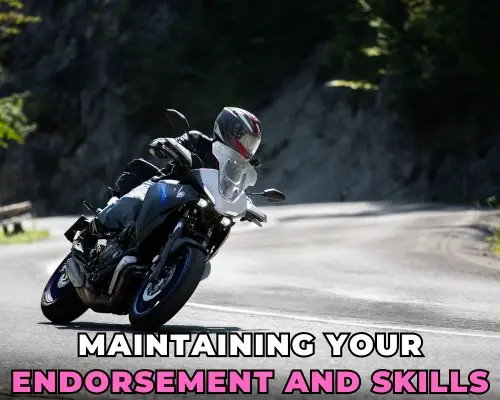
Getting your motorcycle endorsement is only the beginning of your journey; it’s not the conclusion. Like maintaining your bike for a long ride, keeping that endorsement—and the talents it represents—up to date and sharp is important.
Ongoing Education and Training
Think of continuous learning as your road map to becoming not just a good rider, but a great one. It’s an adventure that never ends.
- Enhanced Skills:
- Advanced courses are your path to mastering the ride. Imagine taking tight turns with the precision of a pro or navigating busy streets with ease. These skills aren’t just about looking good; they’re about riding smart and staying alive.
- Improved Safety:
- Every rider’s journey involves close calls. Regular training refines your ability to handle these moments.
It’s like having a sixth sense, one that keeps you one step ahead of trouble. Safety statistics show that continuous training can reduce accident rates by up to 30%.
- Confidence Building:
- Confidence on a bike isn’t just about feeling good—it’s about being in control. Advanced training courses are your chance to face and overcome fears in a controlled, supportive environment.
With each new skill mastered, your confidence grows, making every ride smoother and more enjoyable.
- Skill Refinement:
- Refining your skills is about polishing those rough edges. Advanced braking techniques, quick avoidance maneuvers, and efficient cornering become part of your riding DNA, helping you navigate the road with grace and safety.
Renewal and Recertification
Just like checking your bike before a ride, keeping your endorsement valid requires attention and action.
- Timeline:
- Know when your endorsement and permit expire. It’s like knowing your fuel range; you don’t want to run out unexpectedly. Set reminders a few months in advance to start the renewal process.
- Recertification Requirements:
- Some states require a refresher course or a skills test every few years. Think of it as your bike’s regular tune-up, essential not just for compliance but for safety.
- Documentation:
- Keep a logbook of all your completed courses and certificates, just like you would service records for your motorcycle. These documents are often your ticket to a smooth renewal process.
- Maintaining Skills:
- Regularly participate in advanced rider training and community riding events. These are not just training sessions; they’re networking opportunities with fellow enthusiasts who share tips and experiences that books and classrooms might not cover.
As an Amazon Associate, I earn from qualifying purchases, at no additional cost to you. Read Our Affiliate Disclosure.

